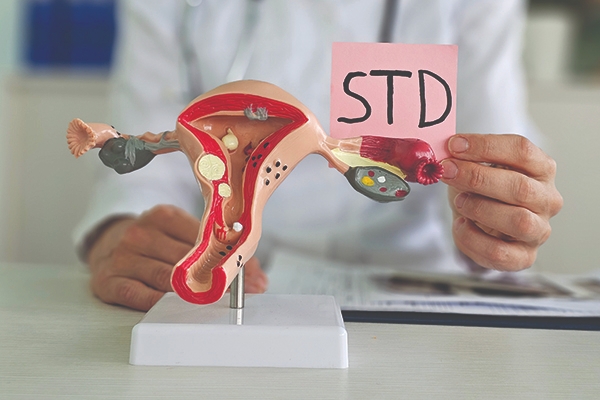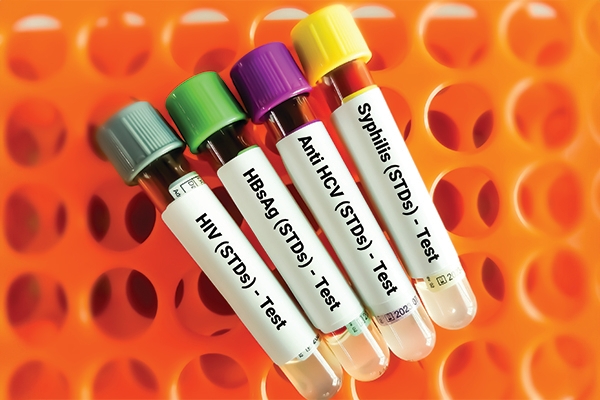Tests for Sexually Transmitted Diseases

Sexually transmitted diseases (STDs), also known as sexually transmitted infections (STIs), are conditions that can be transmitted through various forms of sexual activity—whether through the mouth, anus, vagina, or penis. There are different types of STDs, and each has its symptoms. Some common symptoms include burning, itching, or abnormal discharge from the genital area.
However, not every STD causes symptoms. Since most STDs are asymptomatic, many people remain unaware of their infection and unintentionally transmit it to their partners.
Getting tested early is not only crucial for your health, but it also helps protect your partner from the risk of transmission.
It also helps prevent serious complications, such as damage to internal organs, infertility, and blindness. In some cases, it can even cause death. If you are planning to get pregnant, STD testing is critical to prevent passing the infection to your baby.
Types of STD tests

STD testing usually involves testing blood, urine, or a sample of fluid from the genital area. The type of test needed depends on your symptoms, sexual history, and suspected infection.
1. Hepatitis B
Hepatitis B is a liver infection caused by the hepatitis B virus (HBV). Because this disease rarely causes symptoms, many people are unaware they have been infected for years.
If left untreated, hepatitis B can cause severe liver damage, including fibrosis, cirrhosis, liver cancer, and liver failure.
Read more: Hepatitis B and C: Are They Still The Scariest?
Therefore, it is critical to check liver health routinely. One way is through a blood test.

2. Syphilis
Syphilis is a sexually transmitted infection caused by the bacterium Treponema pallidum. It spreads through sexual contact and begins with a small, usually painless sore.
Read more: Syphilis: Know the Symptoms, Causes, and Treatments
This sore can appear on the genitals, rectum, or mouth and is primarily transmitted through direct contact.
If left untreated, syphilis can be a life-threatening disease. The syphilis test is usually done through a blood test by taking a small sample of blood from a vein in the arm.
There are two types of syphilis tests:
1. VDRL (Venereal Disease Research Laboratory)
The VDRL test is an initial (screening) test to detect whether the body produces specific antibodies due to syphilis infection.
However, this test does not directly detect the bacteria that cause syphilis but instead measures IgG and IgM antibodies that appear due to tissue damage due to infection.
Advantages: It has high sensitivity, which means it can detect infection in many cases.
Disadvantages: Less specific. A positive test does not always indicate that someone has syphilis, because these antibodies might also appear due to infection or other diseases.
A positive result must be confirmed with further testing because VDRL is an initial screening test.
2. TPHA (Treponema pallidum Hemagglutination Assay)
Unlike VDRL, the TPHA test detects specific antibodies to the Treponema pallidum bacteria, making the results more accurate and exact.
Advantages: Can be used to confirm both active and past syphilis infections.
Disadvantages: Positive results can persist for life, even after successful treatment. Therefore, TPHA cannot tell whether the infection is still active or just shows traces of an old infection that has cleared.
This test is often used with a non-treponemal test (such as VDRL) to provide more comprehensive results and determine an infection's stage and status.
2. HIV
HIV (Human Immunodeficiency Virus) is a virus that attacks the immune system, specifically the cells that help fight infection. When these cells are damaged, the body becomes more susceptible to infections and other diseases.
HIV is transmitted through contact with an infected person's bodily fluids, such as blood, semen, vaginal fluids, rectal fluids, or breast milk. Transmission most commonly occurs through unprotected sex or sharing needles.
If left untreated, HIV infection can progress to AIDS (Acquired Immunodeficiency Syndrome), a chronic, life-threatening condition.
HIV tests are intended to detect the presence of the virus or the body's response to HIV infection. Here are some types:
1. HIV antibody test
This test detects antibodies produced by the body to fight HIV. These antibodies appear several weeks after initial exposure.
- Lab test (blood from a vein): This test can detect HIV antibodies 23–90 days after infection. Results are often available within a few days.
- Rapid test (saliva, urine, or finger prick): Results are available within 30 minutes.
However, because antibodies take time to build, it is possible to test negative even though someone is already infected with HIV. This is known as the window period.
2. Antibody/antigen test (combination test)
This is the most commonly used HIV test today. It looks for not only antibodies and HIV antigens, which are parts of the virus that appear earlier than antibodies.
- Lab test (blood from a vein): Can detect HIV 18–45 days after infection.
- Rapid test (blood from a finger prick): Usually detects HIV within 18–90 days.
3. Herpes simplex
The herpes simplex virus (HSV) can infect many body parts. The most common are the mouth (oral herpes) and genitals (genital herpes). HSV causes fluid-filled blisters that break and crust over at the site of infection.
HSV is highly contagious. It is spread from person to person through skin-to-skin contact. Herpes simplex infection occurs when the virus enters the body through the skin and mucous membranes.
The herpes simplex virus (HSV) Anti IgM and IgG test is a blood test used to detect whether someone has ever been infected with HSV-1 or HSV-2.
The test detects IgM and IgG antibodies. A positive IgM result indicates an acute infection, while a positive IgG result indicates a previous herpes infection or history.
**
Many sexually transmitted diseases (STDs) do not show symptoms in the early stages, making them easy to overlook until they cause serious complications.
Getting tested regularly is not just about knowing your personal health status—it is also a form of responsibility to your partner and those around you.
STI testing is not something to be ashamed of; it is an innovative and courageous step to maintain your quality of life and prevent further transmission.
GWS Medika offers safe and fast testing services for sexually transmitted infections. You can undergo testing without fear or embarrassment with professional facilities and an experienced medical team. Don’t wait until it’s too late—schedule your test today.



